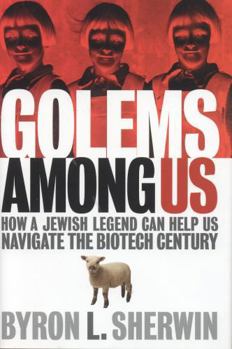Golems Among Us: How a Jewish Legend Can Help Us Navigate the Biotech Century
Select Format
Select Condition 
Book Overview
Mr. Sherwin briefly traces the fascinating history of the golem legend in Western culture, then shows what lessons it holds for us in navigating a safe journey-philosophically, theologically, ethically, and in public policy-through the minefield of twenty-first-century social and biological engineering in which we now stand. "A fascinating journey....Sherwin's compassion, humor, and intellect provide a moral compass to help us navigate through astonishing, promising, and sometimes perilous developments in biotechnology."-Lori Andrews.
Format:Hardcover
Language:English
ISBN:1566635683
ISBN13:9781566635684
Release Date:May 2004
Publisher:Ivan R. Dee Publisher
Length:258 Pages
Weight:1.05 lbs.
Dimensions:0.8" x 6.3" x 9.2"
Customer Reviews
1 rating
A must for theologians, medical ethicists, sci-fi fans, and anyone who likes a good debate.
Published by Thriftbooks.com User , 18 years ago
Sherwin dedicates the first four chapters to retelling the legends of the Golem, namely his fond memories of his Polish grandmother's stories. Chapter five is his transition and by chapter six he is debating genetically engineered v. organic foods. He then progresses to the issues of cloning, robotics, and out of control corporations. The most famous Golem legend is that of Rabbi Judah Loew of 16th century Prague. He was a Kabbalahist, a mystic, who created a Golem by reciting a secret incantation using the tetragrammation of G-d's name. (Sherwin points out that DNA sequences are also tetragrammations and legend has it that G-d brought the universe into existence with divine utterances.) The Golem is a humanoid creature, usually fashioned out of clay. The Golem is usually mute, has no soul, and is slated for destruction once his mission is accomplished. Don't confuse the Golem with Frankenstein. The Golem is many centuries older and while it might have influenced Mary Shelley's Frankenstein the Greco-Roman myth of Prometheus was part of the original subtitle. Rabbi Loew was not a mad scientist, he created the Golem to save his people, and the Golem was always under his control. Sherwin takes the position that cloning is not contrary to Halacha, Torah Law. He points out that Adam was also fashioned by G-d from the clay and then given a soul. As Eve was molded from Adam's side neither was conceived. He alludes to man's having been given dominion over the earth and that we are to be imitators of G-d, not usurpers like those who built the Tower of Babel. Man can not technically play G-d until he creates something from nothing as opposed to taking raw material and refining, transplanting it, etc. What Sherwin does NOT broach is the Torah's prohibition against crossbreeding species or even planting different crops together. (In fact, orthodox Jews will not wear sha'atnez, clothing that contains fibers from both plant and animal sources.) When I think about this prohibition the calamity of killer bees usually comes to mind. There is also a bit of confusion surrounding the terminology used describe fertilized eggs or pre-embryos, technically they are zygotes. The zygote does not begin implanting until about a week after conception and is not considered an embryo until the second week. During this two week period the zygote is simply replicating clumps of cells and has no discernable human characteristics. Given that Sherwin has an obvious bias in favor of stem-cell research he should have clarified his opponents' attempts to obfuscate the general public. Sherwin's tone is optimistic when describing future cyborgs, humans and machines combined, but he also offers scary fodder for science fiction writers. What I found most riveting was the chapter, "Corporate Golems." He gives a brief history of corporations in the US and Europe. He compares corporations to the Frankenstein monster, as they have incredible rights and power and very few responsibilit






